Basalt-Fiber-Reinforced Polyvinyl Acetate Resin: A Coating for Ductile Plywood Panels
Abstract
1. Introduction
2. Materials and Methods
2.1. Panel Production
2.2. Testing of Panel Properties
3. Results and Discussion
3.1. Density
3.2. Ultimate Bending Load and Bending Stiffness (EI)
3.3. Impact Strength
4. Conclusions
Author Contributions
Funding
Acknowledgments
Conflicts of Interest
References
- Wilk, C. Plywood: A Material Story, 1st ed.; Thames & Hudson: London, UK, 2017; ISBN 978-0500519400. [Google Scholar]
- Lefeuvre, A.; Garnier, S.; Jacquemin, L.; Pillain, B.; Sonnemann, G. Anticipating in-use stocks of carbon fiber reinforced polymers and related waste flows generated by the commercial aeronautical sector until 2050. Resour. Conserv. Recycl. 2017, 125, 264–272. [Google Scholar] [CrossRef]
- Jacob, A. Composites can be recycled. Reinf. Plast. 2011, 55, 45–46. [Google Scholar] [CrossRef]
- Falk, B. Wood as a Sustainable Building Material. For. Prod. J. 2009, 59, 6–12. [Google Scholar]
- Weichand, P.; Gadow, R. Basalt fibre reinforced SiOC-matrix composites: Manufacturing technologies and characterisation. J. Eur. Ceram. Soc. 2015, 35, 4025–4030. [Google Scholar] [CrossRef]
- Tout, R. A review of adhesives for furniture. Int. J. Adhes. Adhes. 2000, 20, 269–272. [Google Scholar] [CrossRef]
- Cobut, A.; Blanchet, P.; Beauregard, R. The environmental footprint of interior wood doors in non-residential buildings—Part 1: Life cycle assessment. J. Clean. Prod. 2015, 109, 232–246. [Google Scholar] [CrossRef]
- Lu, J.; Easteal, A.J.; Edmonds, N.R. Crosslinkable poly(vinyl acetate) emulsions for wood adhesive. Pigment Resin Technol. 2011, 40, 161–168. [Google Scholar] [CrossRef]
- Amann, M.; Minge, O. Biodegradability of Poly(vinyl acetate) and Related Polymers. In Advances in Polymer Science; Springer: Berlin/Heidelberg, Germany, 2011; Volume 245, pp. 137–172. [Google Scholar]
- Kawabata, N.; Kurooka, T. Biodegradability of poly(vinyl acetate) containing a pyridinium group. J. Appl. Polym. Sci. 1995, 56, 509–516. [Google Scholar] [CrossRef]
- Konnerth, J.; Gindl, W.; Müller, U. Elastic properties of adhesive polymers. I. Polymer films by means of electronic speckle pattern interferometry. J. Appl. Polym. Sci. 2007, 103, 3936–3939. [Google Scholar] [CrossRef]
- Ku, H.; Wang, H.; Pattarachaiyakoop, N.; Trada, M. A review on the tensile properties of natural fiber reinforced polymer composites. Compos. Part B Eng. 2011, 42, 856–873. [Google Scholar] [CrossRef]
- Meredith, J.; Bilson, E.; Powe, R.; Collings, E.; Kirwan, K. A performance versus cost analysis of prepreg carbon fibre epoxy energy absorption structures. Compos. Struct. 2015, 124, 206–213. [Google Scholar] [CrossRef]
- Oliveux, G.; Dandy, L.O.; Leeke, G.A. Current status of recycling of fibre reinforced polymers: Review of technologies, reuse and resulting properties. Prog. Mater. Sci. 2015, 72, 61–99. [Google Scholar] [CrossRef]
- Naqvi, S.R.; Prabhakara, H.M.; Bramer, E.A.; Dierkes, W.; Akkerman, R.; Brem, G. A critical review on recycling of end-of-life carbon fibre/glass fibre reinforced composites waste using pyrolysis towards a circular economy. Resour. Conserv. Recycl. 2018, 136, 118–129. [Google Scholar] [CrossRef]
- Fiore, V.; Scalici, T.; Di Bella, G.; Valenza, A. A review on basalt fibre and its composites. Compos. Part B Eng. 2015, 74, 74–94. [Google Scholar] [CrossRef]
- Branston, J.; Das, S.; Kenno, S.Y.; Taylor, C. Mechanical behaviour of basalt fibre reinforced concrete. Constr. Build. Mater. 2016, 124, 878–886. [Google Scholar] [CrossRef]
- Azrague, K.; Inman, M.R.; Alnæs, L.I.; Schlanbusch, R.D.; Johannesson, B.; Sigfusson, T.I.; Thorhallsson, E.R.; Franzson, H.; Arnason, A.B.; Vares, S. Life cycle assessment as a tool for resource optimisation of continuous basalt fibre production in Iceland. In Proceedings of the ECI Symposium Series, Cetraro, Italy, 5–10 June 2016. [Google Scholar]
- Inman, M.; Thorhallsson, E.R.; Azrague, K. A Mechanical and Environmental Assessment and Comparison of Basalt Fibre Reinforced Polymer (BFRP) Rebar and Steel Rebar in Concrete Beams. Energy Procedia 2017, 111, 31–40. [Google Scholar] [CrossRef]
- Artemenko, S.E.; Kadykova, Y.A. Polymer composite materials based on carbon, basalt, and glass fibres. Fibre Chem. 2008, 40, 37–39. [Google Scholar] [CrossRef]
- Kufel, A.; Kuciel, S. Basalt/Wood Hybrid Composites Based on Polypropylene: Morphology, Processing Properties, and Mechanical and Thermal Expansion Performance. Materials 2019, 12, 2557. [Google Scholar] [CrossRef]
- Rescalvo, F.J.; Abarkane, C.; Suárez, E.; Valverde-Palacios, I.; Gallego, A. Pine Beams Retrofitted with FRP and Poplar Planks: Mechanical Behavior. Materials 2019, 12, 3081. [Google Scholar] [CrossRef]
- Wdowiak, A.; Brol, J. Effectiveness of Reinforcing Bent Non-Uniform Pre-Stressed Glulam Beams with Basalt Fibre Reinforced Polymers Rods. Materials 2019, 12, 3141. [Google Scholar] [CrossRef]
- Mladen, B.; Vladimir, J.; Stjepan, P. Bending properties of carbon fiber reinforced plywood. Wood Res. 2003, 48, 13–24. [Google Scholar]
- Kramár, S.; Král, P. Reinforcing Effect of a Thin Basalt Fiber-reinforced Polymer Plywood Coating. BioResources 2019, 14, 2062–2078. [Google Scholar]
- Ashori, A.; Ghofrani, M.; Rezvani, M.H.; Ayrilmis, N. Development and material properties of reinforced plywood using carbon fiber and waste rubber powder. Polym. Compos. 2018, 39, 675–680. [Google Scholar] [CrossRef]
- Xu, H.; Nakao, T.; Tanaka, C.; Yoshinobu, M.; Katayama, H. Effects of fiber length and orientation on elasticity of fiber-reinforced plywood. J. Wood Sci. 1998, 44, 343–347. [Google Scholar] [CrossRef]
- Bal, B.C.; Bektaş, I.; Mengeloğlu, F.; Karakuş, K.; Ökkeş Demir, H. Some technological properties of poplar plywood panels reinforced with glass fiber fabric. Constr. Build. Mater. 2015, 101, 952–957. [Google Scholar] [CrossRef]
- Biblis, E.J.; Carino, H.F. Flexural properties of southern pine plywood overlaid with fiberglass-reinforced plastic. For. Prod. J. 2000, 50, 34–36. [Google Scholar]
- Stoeckel, F.; Konnerth, J.; Gindl-Altmutter, W. Mechanical properties of adhesives for bonding wood—A review. Int. J. Adhes. Adhes. 2013, 45, 32–41. [Google Scholar] [CrossRef]
- Mei, C.; Zhou, D. Study on glass fiber reinforced poplar plywood used for concrete form. China For. Sci. Technol. 2009, 23, 79–82. [Google Scholar]
- ISO 2074-Plywood-Vocabulary; European Comittee for Standardization: Brussels, Belgium, 2007.
- ISO 4603-Textile glass-Woven Fabrics-Determination of Thickness; European Comittee for Standardization: Brussels, Belgium, 1993.
- Singha, K. A Short Review on Basalt Fiber. Int. J. Text. Sci. 2012, 1, 19–28. [Google Scholar]
- Guide for the Design and Construction of Externally Bonded FRP Systems for Strengthening Existing Structures; National Research Council: Rome, Italy, 2014.
- Handbook of Finnish Plywood; Finnish Forest Industries Federation: Helsinky, Finland, 2002; ISBN 9529506635.
- EN 310-Wood-Based Panels. Determination of Modulus of Elasticity in Bending and of Bending Strength; European Comittee for Standardization: Brussels, Belgium, 1998.
- ISO 6603-Determination of Puncture Impact Behaviour of Rigid Plastics; European Comittee for Standardization: Brussels, Belgium, 2000.
- ISO 4606-Textile Glass-Woven Fabric-Determination of Tensile Breaking Force and Breaking Elongation by the Strip Method; European Comittee for Standardization: Brussels, Belgium, 1995.
- Reddy, J.N. Theory and Analysis of Elastic Plates and Shells, 2nd ed.; CRC Press: Boca Raton, FL, USA, 2006; ISBN 9780849384165. [Google Scholar]
- Dömény, J.; Čermák, P.; Koiš, V.; Tippner, J.; Rousek, R. Density profile and microstructural analysis of densified beech wood (Fagus sylvatica L.) plasticized by microwave treatment. Eur. J. Wood Wood Prod. 2018, 76, 105–111. [Google Scholar] [CrossRef]
- Kollmann, F.F.P.; Côté, W.A. Principles of Wood Science and Technology; Springer: Berlin/Heidelberg, Germany, 1968; ISBN 978-3-642-87930-2. [Google Scholar]
- Kljak, J.; Brezović, M.; Jambreković, V. Plywood stress optimisation using the finite element method. Wood Res. 2006, 51, 1–10. [Google Scholar]
- Bal, B.C.; Bektaþ, Ý. Some mechanical properties of plywood produced from eucalyptus, beech, and poplar veneer. Maderas. Cienc. Tecnol. 2014, 16, 99–108. [Google Scholar] [CrossRef]
- Sonderegger, W.; Niemz, P. The influence of compression failure on the bending, impact bending and tensile strength of spruce wood and the evaluation of non-destructive methods for early detection. Holz Als Roh Und Werkst. 2004, 62, 335–342. [Google Scholar] [CrossRef][Green Version]
- Wei, P.; Wang, B.J.; Zhou, D.; Dai, C.; Wang, Q.; Huang, S. Mechanical Properties of Poplar Laminated Veneer Lumber Modified by Carbon Fiber Reinforced Polymer. BioResources 2013, 8, 4883–4898. [Google Scholar] [CrossRef]
- Konnerth, J.; Jäger, A.; Eberhardsteiner, J.; Müller, U.; Gindl, W. Elastic properties of adhesive polymers. II. Polymer films and bond lines by means of nanoindentation. J. Appl. Polym. Sci. 2006, 102, 1234–1239. [Google Scholar] [CrossRef]
- Požgaj, A.; Chovanec, D.; Kurjatko, S.; Babiak, M. Structure and Properties Od Wood (In Slovak: Štruktúra a Vlastnosti Dreva), 2nd ed.; Príroda: Bratislava, Slovakia, 1997; ISBN 80-07-00960-4. [Google Scholar]
- Abraham, D.; Matthews, S.; McIlhagger, R. A comparison of physical properties of glass fibre epoxy composites produced by wet lay-up with autoclave consolidation and resin transfer moulding. Compos. Part A Appl. Sci. Manuf. 1998, 29, 795–801. [Google Scholar] [CrossRef]
- Jamshaid, H.; Mishra, R.; Militky, J. Thermal and mechanical characterization of novel basalt woven hybrid structures. J. Text. Inst. 2016, 107, 462–471. [Google Scholar] [CrossRef]
- Bauer, F.; Kempf, M.; Weiland, F.; Middendorf, P. Structure-property relationships of basalt fibers for high performance applications. Compos. Part B Eng. 2018, 145, 121–128. [Google Scholar] [CrossRef]
- Militky, J.; Kovacic, V. Ultimate Mechanical Properties of Basalt Filaments. Text. Res. J. 1996, 66, 225–229. [Google Scholar] [CrossRef]
- Sim, J.; Park, C.; Moon, D.Y. Characteristics of basalt fiber as a strengthening material for concrete structures. Compos. Part B Eng. 2005, 36, 504–512. [Google Scholar] [CrossRef]
- EN 204-Classification of Thermoplastic Wood Adhesives for Non-Structural Applications; European Comittee for Standardization: Brussels, Belgium, 2002.
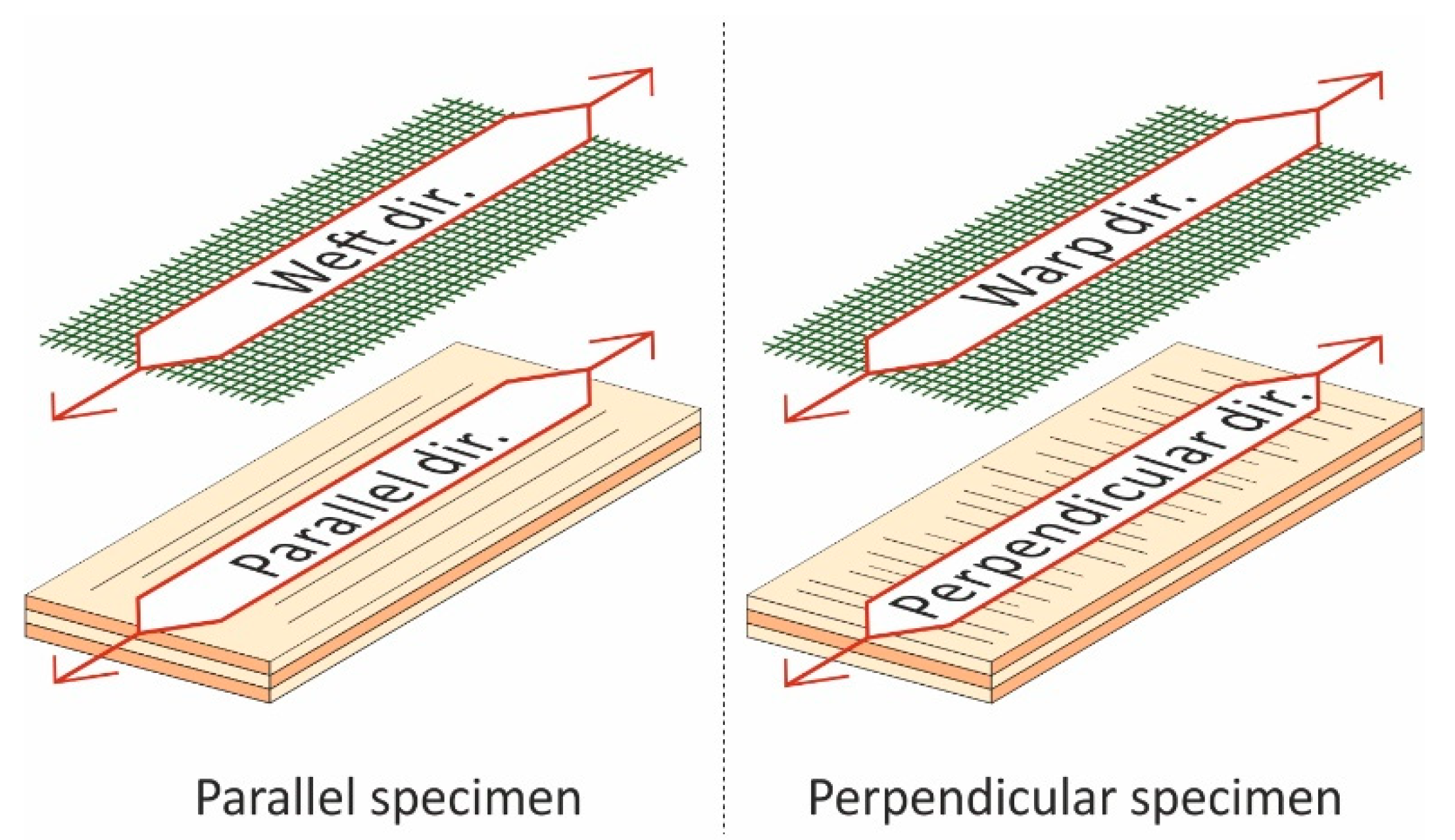

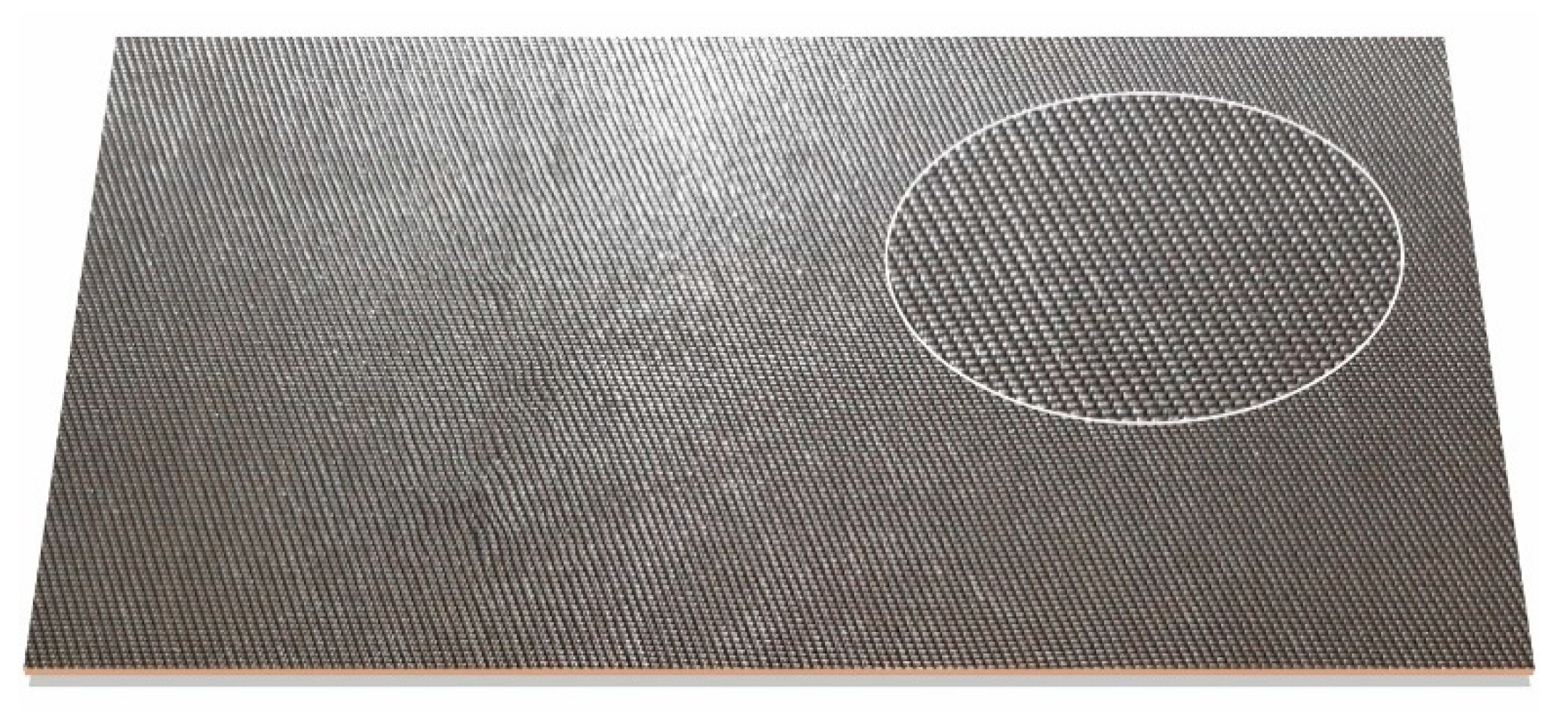
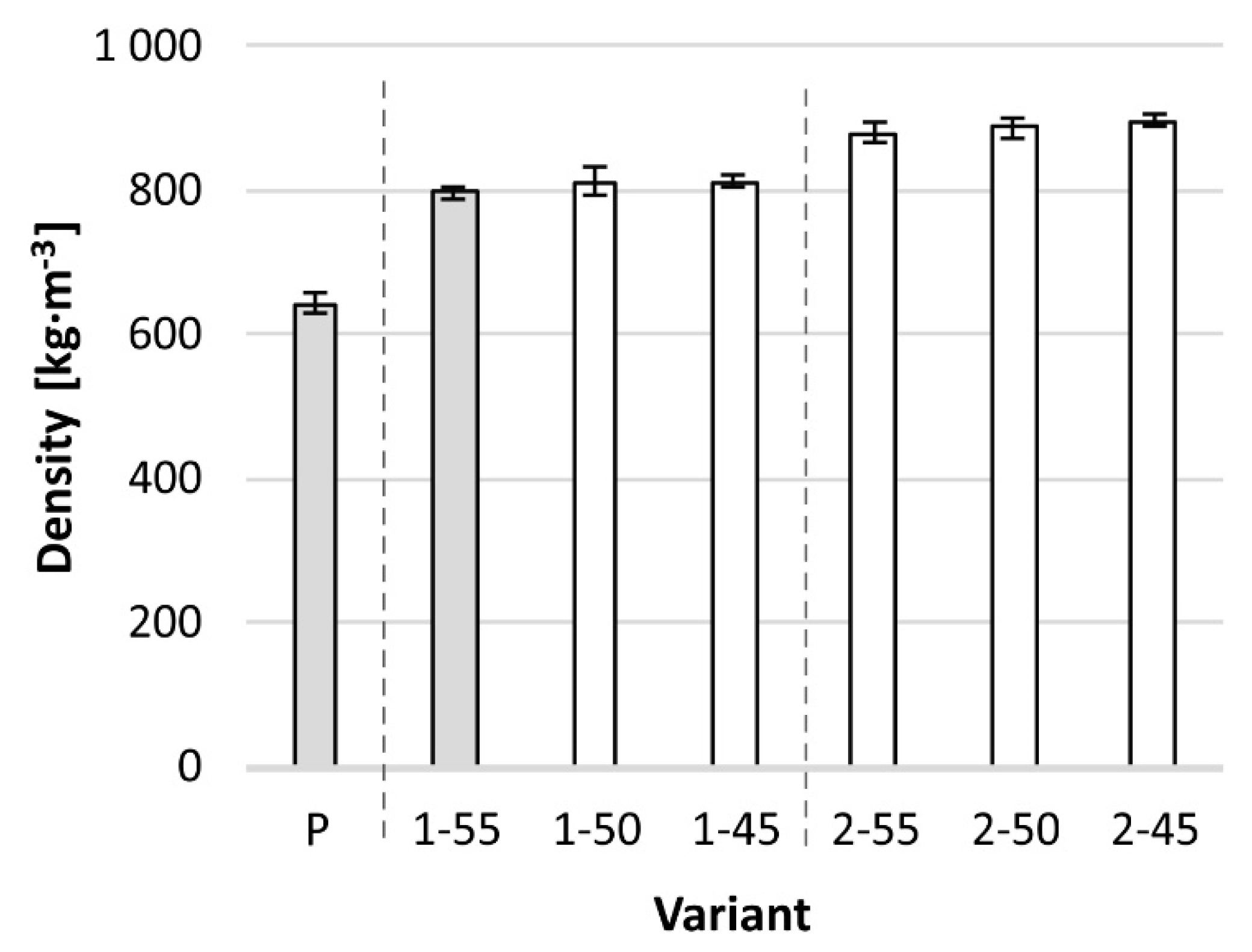

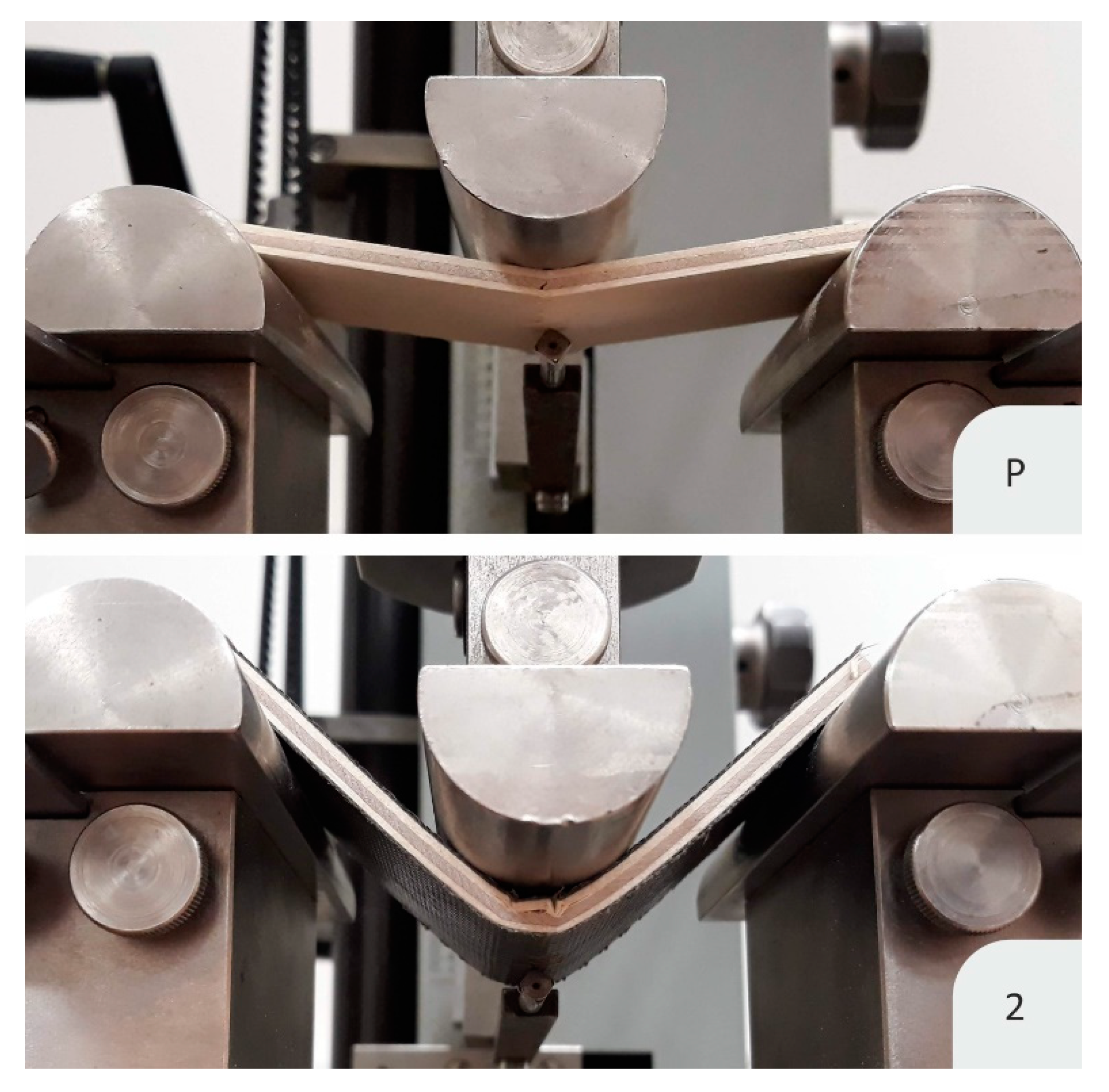
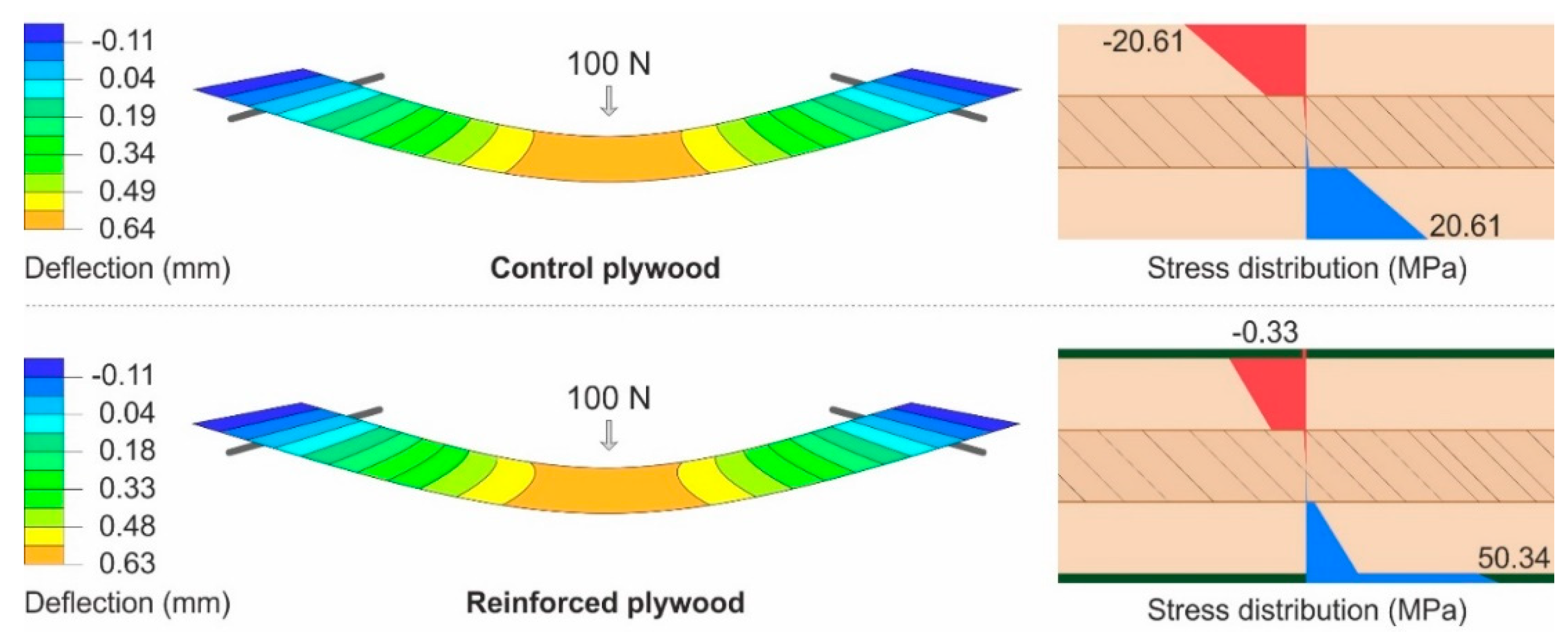
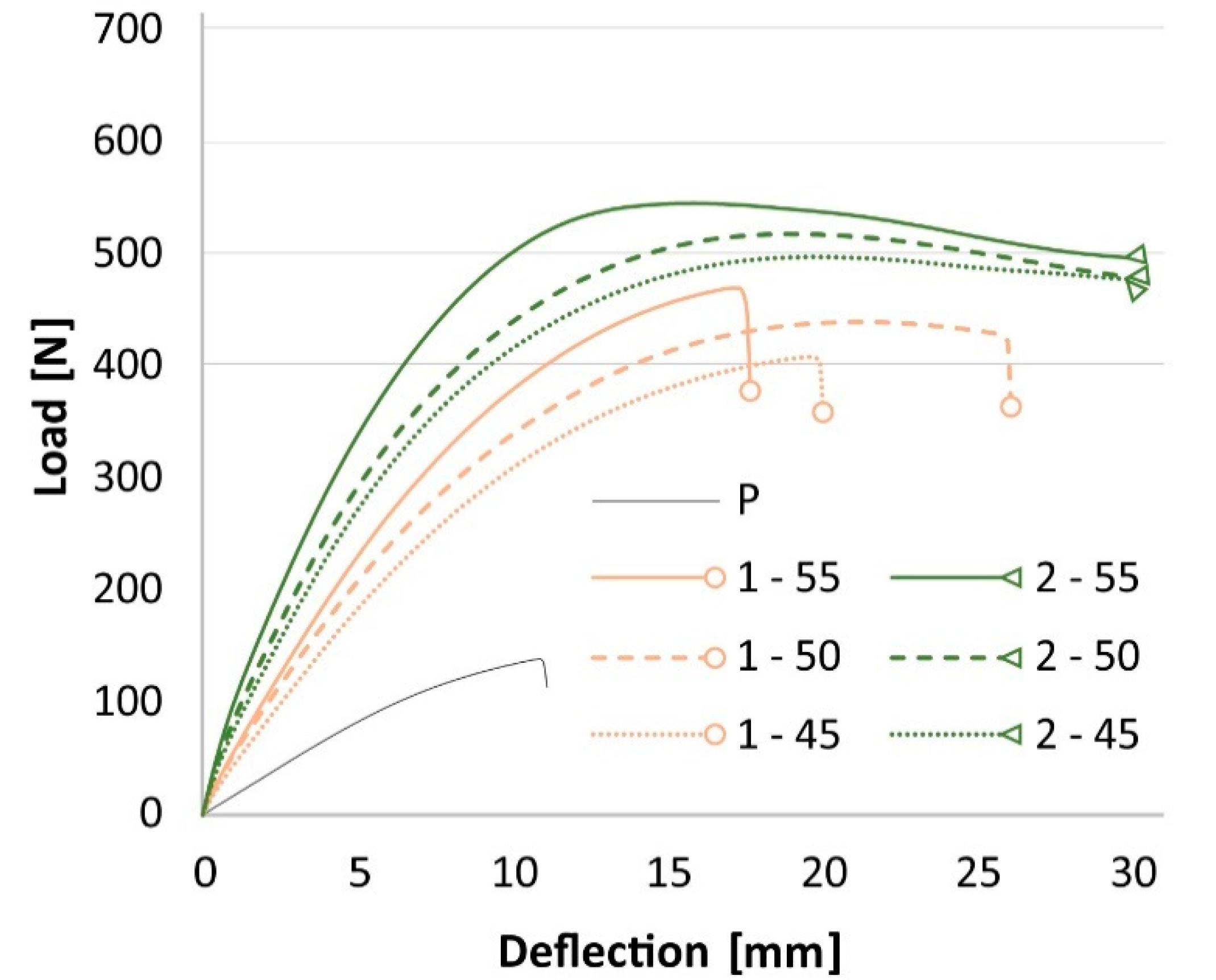
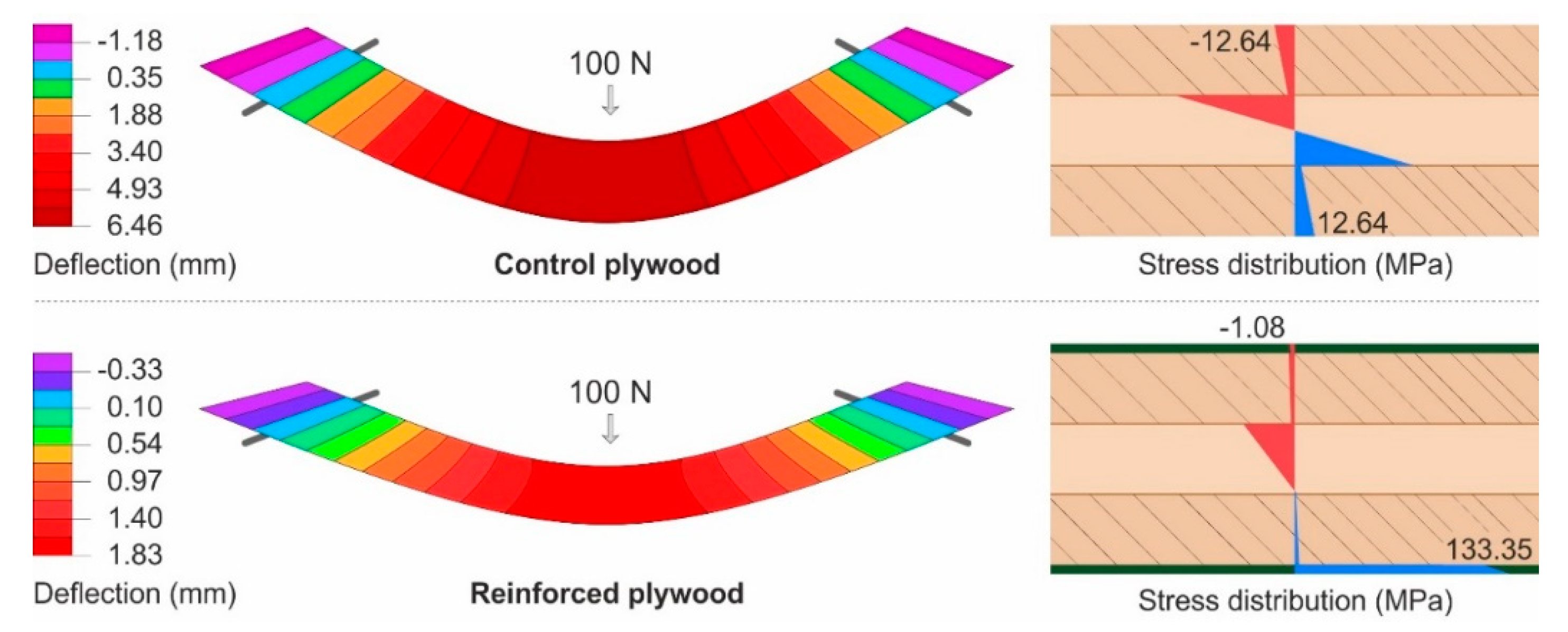
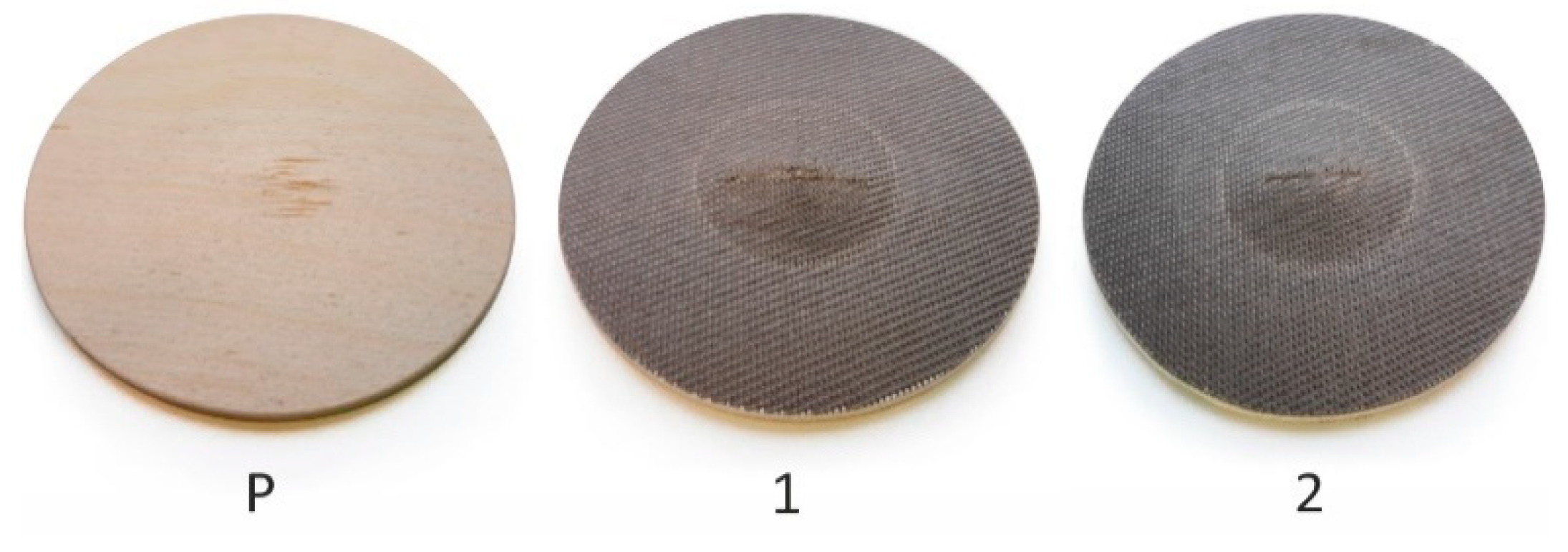
| Variant | Number of Reinforcing Layers * | Fiber Fraction [%] | n1 | n2 |
|---|---|---|---|---|
| P | 0 | n/a | 20 | 16 |
| 1–55 | 1 | 55 | 20 | 16 |
| 1–50 | 1 | 50 | 20 | 16 |
| 1–45 | 1 | 45 | 20 | 16 |
| 2–55 | 2 | 55 | 20 | 16 |
| 2–50 | 2 | 50 | 20 | 16 |
| 2–45 | 2 | 45 | 20 | 16 |
| Ultimate Load [N] | EI [×103 Nmm2] | |||||
|---|---|---|---|---|---|---|
| Variant | Mean | St. Dev. | ANOVA | Mean | St. Dev. | ANOVA |
| P | 502 | 25.6 | 3355 | 212 | ||
| 1–55 | 537 | 29.5 | 3698 | 236 | ||
| 1–50 | 563 | 31.0 | 3443 | 157 | ||
| 1–45 | 570 | 29.5 | 3443 | 121 | ||
| 2–55 | 658 | 42.0 | *** | 4527 | 130 | *** |
| 2–50 | 651 | 45.8 | *** | 4112 | 355 | *** |
| 2–45 | 636 | 29.7 | *** | 3937 | 229 | *** |
| Ultimate Load [N] | EI [×103 Nmm2] | |||||
|---|---|---|---|---|---|---|
| Variant | Mean | St. Dev. | ANOVA | Mean | St. Dev. | ANOVA |
| P | 135 | 21.5 | 339 | 45 | ||
| 1–55 | 465 | 24.0 | *** | 896 | 56 | *** |
| 1–50 | 435 | 14.8 | *** | 795 | 26 | |
| 1–45 | 415 | 13.7 | *** | 754 | 33 | |
| 2–55 | 545 | 24.0 | *** | 1441 | 60 | *** |
| 2–50 | 513 | 31.4 | 1215 | 110 | *** | |
| 2–45 | 510 | 30.4 | 1234 | 141 | *** | |
| Impact Energy [J] | |||
|---|---|---|---|
| Variant | Mean | St. Dev. | ANOVA |
| P | 0.5 | 0.1 | |
| 1–55 | 20.0 | 1.4 | *** |
| 1–50 | 19.9 | 0.9 | *** |
| 1–45 | 19.9 | 1.5 | *** |
| 2–55 | 30.9 | 1.2 | *** |
| 2–50 | 30.7 | 1.3 | *** |
| 2–45 | 30.8 | 1.0 | *** |
© 2019 by the authors. Licensee MDPI, Basel, Switzerland. This article is an open access article distributed under the terms and conditions of the Creative Commons Attribution (CC BY) license (http://creativecommons.org/licenses/by/4.0/).
Share and Cite
Kramár, S.; Trcala, M.; Chitbanyong, K.; Král, P.; Puangsin, B. Basalt-Fiber-Reinforced Polyvinyl Acetate Resin: A Coating for Ductile Plywood Panels. Materials 2020, 13, 49. https://doi.org/10.3390/ma13010049
Kramár S, Trcala M, Chitbanyong K, Král P, Puangsin B. Basalt-Fiber-Reinforced Polyvinyl Acetate Resin: A Coating for Ductile Plywood Panels. Materials. 2020; 13(1):49. https://doi.org/10.3390/ma13010049
Chicago/Turabian StyleKramár, Samuel, Miroslav Trcala, Korawit Chitbanyong, Pavel Král, and Buapan Puangsin. 2020. "Basalt-Fiber-Reinforced Polyvinyl Acetate Resin: A Coating for Ductile Plywood Panels" Materials 13, no. 1: 49. https://doi.org/10.3390/ma13010049
APA StyleKramár, S., Trcala, M., Chitbanyong, K., Král, P., & Puangsin, B. (2020). Basalt-Fiber-Reinforced Polyvinyl Acetate Resin: A Coating for Ductile Plywood Panels. Materials, 13(1), 49. https://doi.org/10.3390/ma13010049





